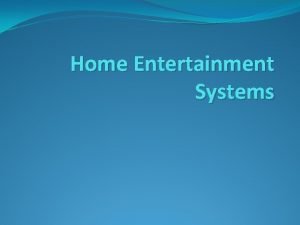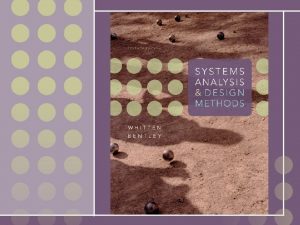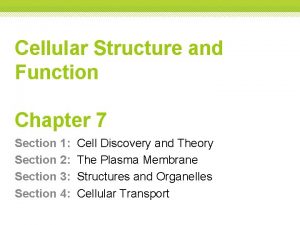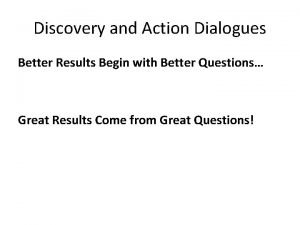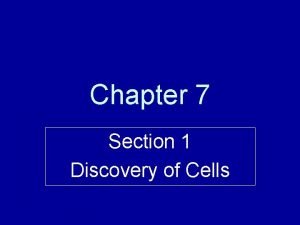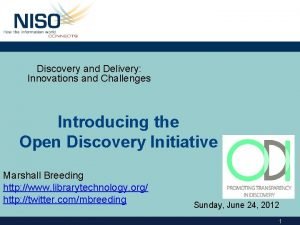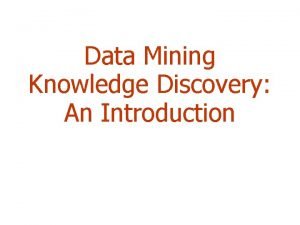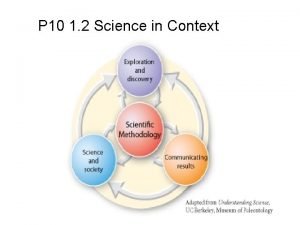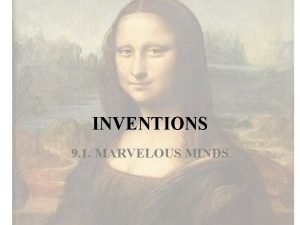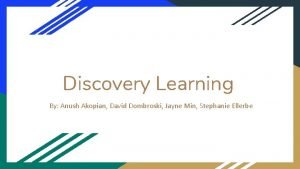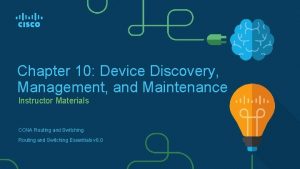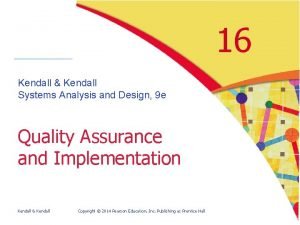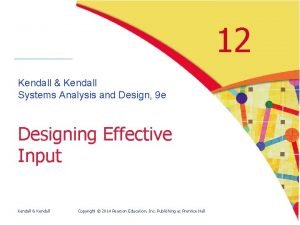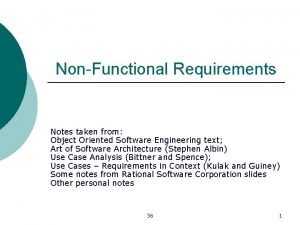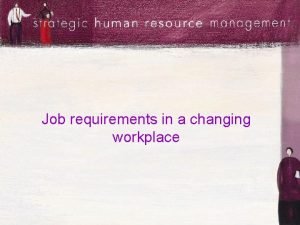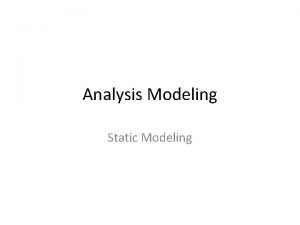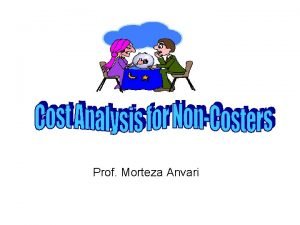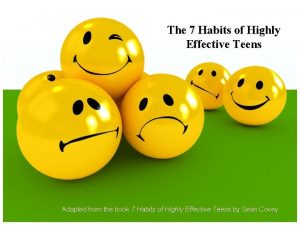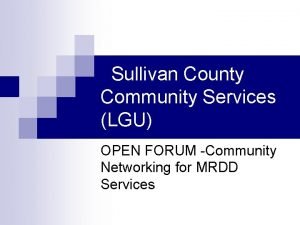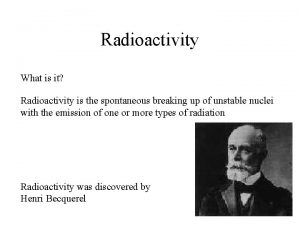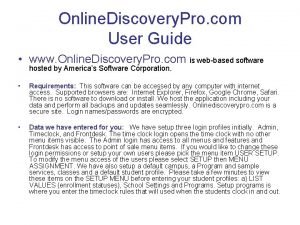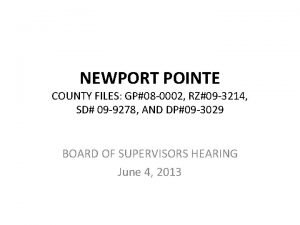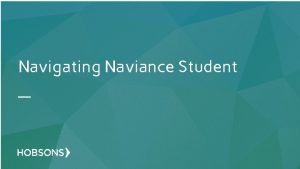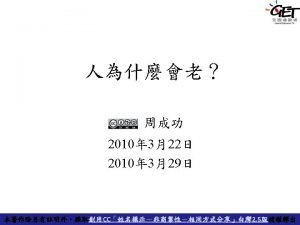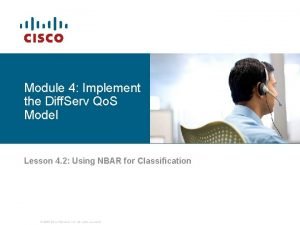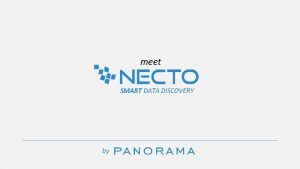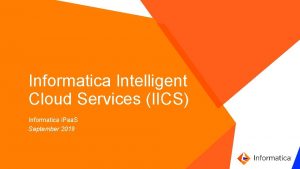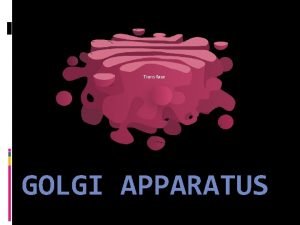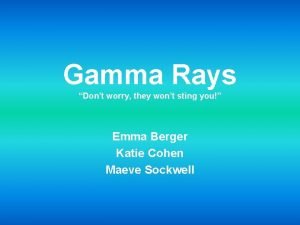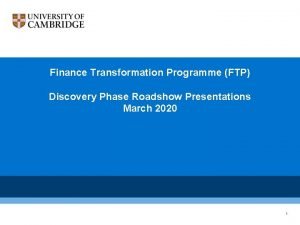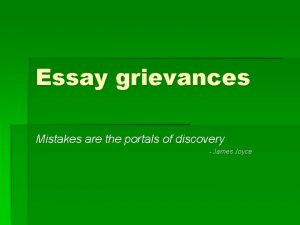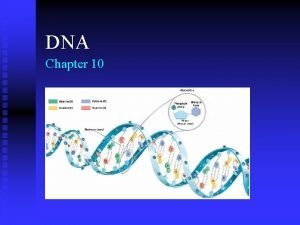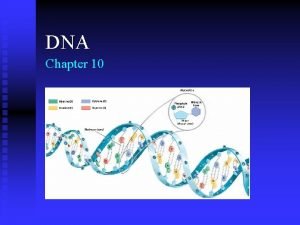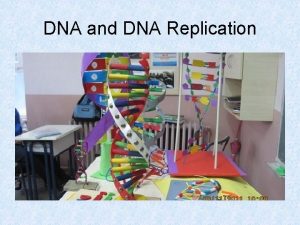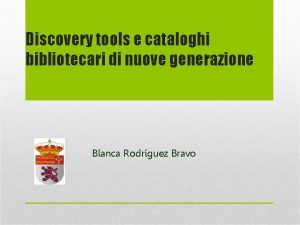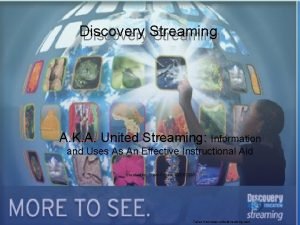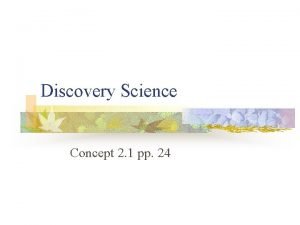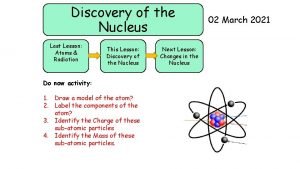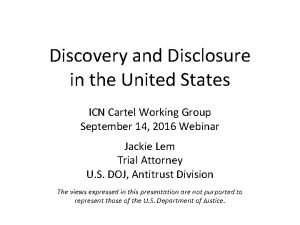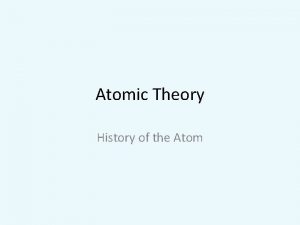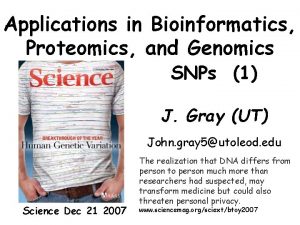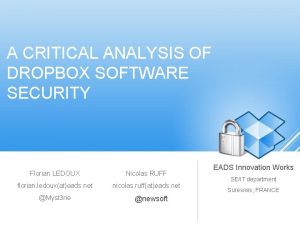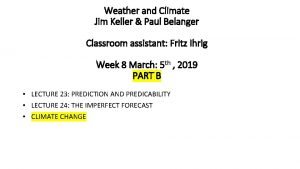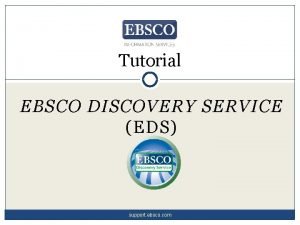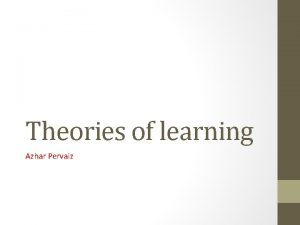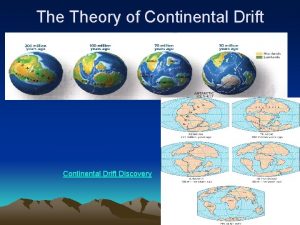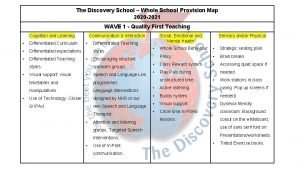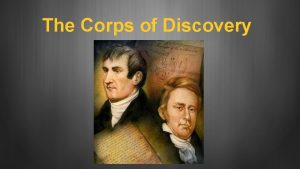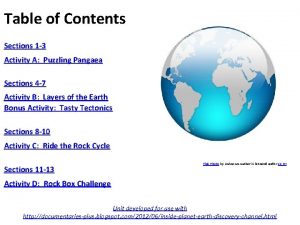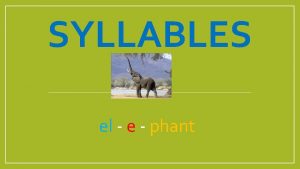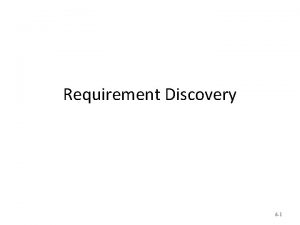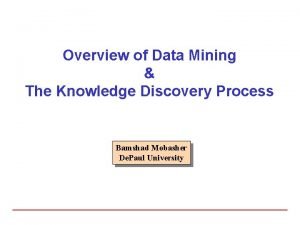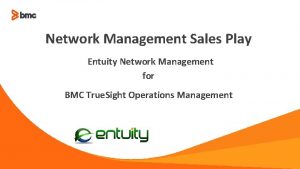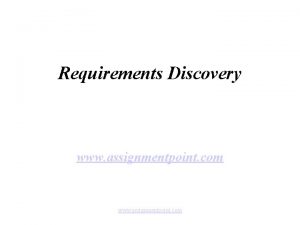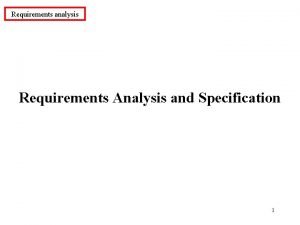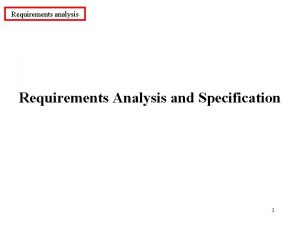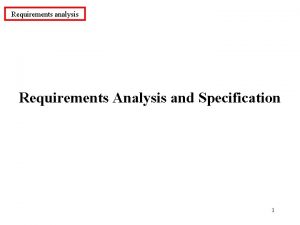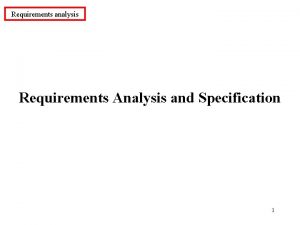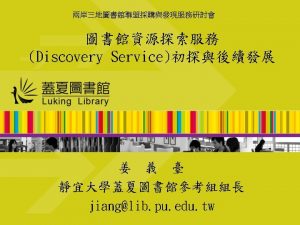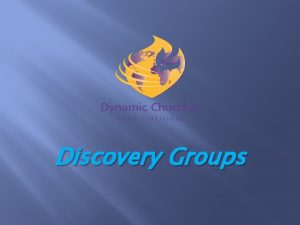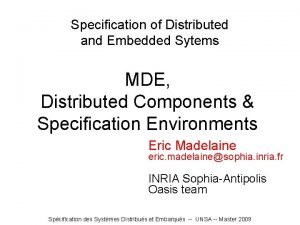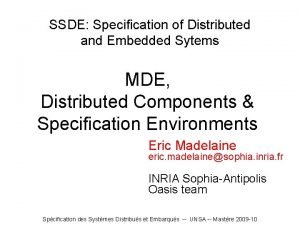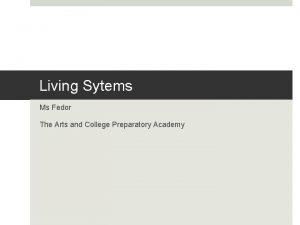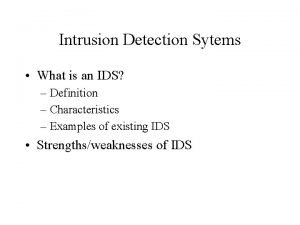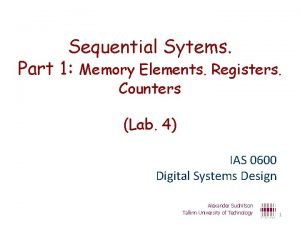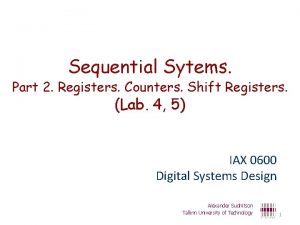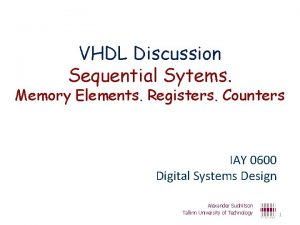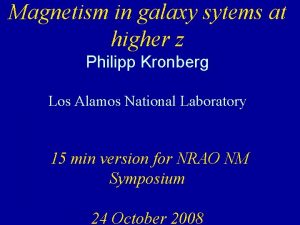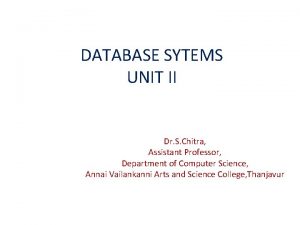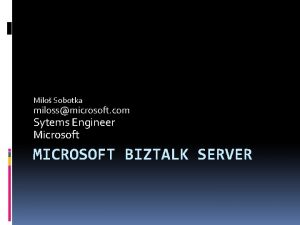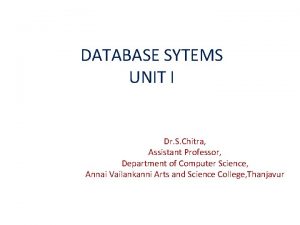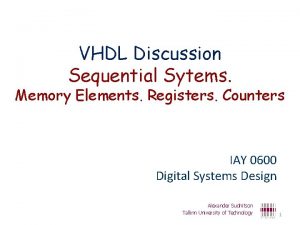SYTEMS ANALYSIS AND DESIGN REQUIREMENTS DISCOVERY 1 REQUIREMENTS



















































































- Slides: 83

SYTEMS ANALYSIS AND DESIGN REQUIREMENTS DISCOVERY 1

REQUIREMENTS DISCOVERY The process and techniques used by systems analysts to identify or extract system problems and solution requirements from the user community. System requirement – something that the information system must do or a property that it must have. Also called a business requirement. 2

Characteristics of System Analyst in Requirements Determination w Impartiality: Fairness is important, consider issues raised by all parties, your job is to find the best solution to a business problem and not to for example, justify the purchase of new hardware, or impose your views on users. 3

w Relax Constraints: - Assume that anything is possible and eliminate the infeasible. Avoid statements like we have always done it that way. Traditions are different from rules and policies. Organizations and environments change, traditions can turn into habit rather than sensible procedures 4

w Reframing: - Analysis is a creative process. You must challenge yourself to look at the organization in new ways. You must consider how each user views his her requirements. Avoid jumping to the conclusion that the new system must work the same way as the one you have built before 5

PIECES CLASSIFICATION OF requirements discovery 6

Results of incorrect requirements discovery w The system may cost more than projected. w The system may be delivered later than promised. w The system may not meet the users’ expectations and that dissatisfaction may cause them not to use it. w Once in production, the costs of maintaining and enhancing the system may be excessively high. 7

Results of incorrect requirements discovery…. w The system may be unreliable and prone to errors. w The reputation of the IT staff on the team is tarnished because any failure, regardless of who is at fault, will be perceived as a mistake by the team. 8

Criteria to Define System Requirements w Complete – requirements describe all possible system inputs and responses. w Consistent – requirements are not conflicting or ambiguous. w Feasible – requirements can be satisfied based on the available resources and constraints. 9

Criteria to Define System Requirements…. . w Required – requirements are truly needed and fulfill the purpose of the system. w Accurate – requirements are stated correctly. w Traceable – requirements directly map to the functions and features of the system. w Verifiable – requirements are defined so they can be demonstrated during testing. 10

FACT FINDING The formal process of using research, meetings, interviews, questionnaires, sampling, and other techniques to collect information about system problems, requirements, and preferences. It is also called information gathering or data collection. 11

Fact-Finding Ethics…. w Fact-Finding often brings systems analysts into contact with sensitive information. – Company plans – Employee salaries or medical history – Customer credit card, social security, or other information 12

Fact-Finding Ethics…. w Ethical behavior includes: – Systems analysts must not misuse that information. – Systems analysts must protect that information from people who would misuse it. 13

Fact-Finding Ethics…… w Otherwise: – Systems analyst loses respect, credibility, and confidence of users and management, impairing ability to do job – Organization and systems analyst could have legal liability – Systems analyst could lose job 14

Information can be got from: (1) Existing documents e. g. w Organization charts w Policy manuals w Procedural manuals w Job descriptions w Forms, reports w Document flow and work flow diagrams 15

Information can be got from: -…. . w Systems flow charts w If computerized – Computer program documentation – Data dictionary listings – Computer operation manuals 16

Information can be got from: -…. (2) System users and managers (3) External sources: Might be necessary especially when examining alternatives for the new systems. To see what is available w Other companies w Equipment and software vendors w Business publications, seminars, workshops, or visits to show rooms, exhibitions, or other companies for demonstrations. 17

w Methods of Gathering Information: The existing systems must be understood before they can be comprehensively designed. The best way of understanding the activities that take place in any particular system whether computerized or manual is to get information from the users and other processing areas. 18

Fact finding methods w Sampling of existing documentation, forms, and databases. w Research and site visits. w Observation of the work environment. w Questionnaires. w Interviews. w Prototyping. w Joint requirements planning (JRP). 19

Sampling – the process of collecting a representative sample of documents, forms, and records. –Organization chart –Memos and other documents that describe the problem –Standard operating procedures for current system 20

Sampling… – Completed forms – Manual and computerized screens and reports – Samples of databases – Flowcharts and other system documentation – And more 21

Why blank forms? w Can determine the type of data going into each blank w Can determine the size of data going into each blank w Can determine which blanks are not used or not always used w Can see data relationships 22

23

Observation – a fact-finding technique wherein the systems analyst either participates in or watches a person perform activities in order to learn about the system. 24

Guidelines to observation w Determine the who, what, where, when, why, and how of the observation. w Obtain permission from appropriate supervisors or managers. w Inform those who will be observed of the purpose of the observation. w Keep a low profile. 25

Guidelines to observation…. w Take notes during or immediately following the observation. w Review observation notes with appropriate individuals. w Don't interrupt the individuals at work. w Don't focus heavily on trivial activities. w Don't make assumptions. 26

Advantages of Observation w Data gathered is highly reliable. w The system analyst can see exactly what happens especially for tasks, which are difficult to explain in words. w It allows the system analyst to do some measurements or estimations. w It is relatively inexpensive compared to other techniques. w The analyst gets first hand information. 27

Disadvantages of Observation w Tendency of people to exaggerate behavior when they know they are being observed. w The activities may take place at odd hours hence inconveniencing the analyst. w The system analyst may end up observing exceptional activities only. w It is subject to bias opinion. 28

Questionnaire – a special-purpose document that allows the analyst to collect information and opinions from respondents. 29

Types of Questions Open-ended question – a question that allows the interviewee to respond in any way that seems appropriate. Closed-ended question – a question that restricts answers to either specific choices or short, direct responses. 30

When to Use Questionnaires w When the system analyst is located at a considerable distance from the staff to be questioned. w When there is a large number of respondents such that interviewing is prohibited by the time available. 31

When to Use Questionnaires… w When the questions are simple and they call for direct answer. w When limited amount of information is required from a large number of people. w When it is to be used as a means of verifying information found or gathered using other methods 32

Advantages of Questionnaires w They provide inexpensive method of gathering data from a large number of people. w Allows individuals to maintain your identity (anonymity) hence they can provide real facts. w The questions are presented consistently to all the respondents without bias. w The respondents can complete the questionnaire at their own convenience 33

Disadvantages of Questionnaires…. w The number that responds is often too low. w They provide no opportunity for clarification. w It is not possible for the analyst to observe and analyze body expressions w There is no guarantee that the individuals will respond to all the questions. w Good questionnaires are difficult to prepare. 34

Interviews Interview - a fact-finding technique whereby the systems analysts collect information from individuals through face-to-face interaction. – Can be used to: • Find facts • Verify facts • Clarify facts 35

Interviews…. • Generate enthusiasm • Get the end-user involved • Identify requirements • Solicit ideas and opinions 36

Types of interviews Unstructured interview – an interview that is conducted with only a general goal or subject in mind and with few, if any, specific questions. The interviewer counts on the interviewee to provide a framework and direct the conversation. Structured interview – an interview in which the interviewer has a specific set of questions to ask of the interviewee. 37

Procedure to Conduct an Interview 1. Select Interviewees – End users – Learn about individual prior to the interview 2. Prepare for the Interview – An interview guide is a checklist of specific questions the interviewer will ask the interviewee. 38

Procedure to Conduct an Interview…. 3. Conduct the Interview – Summarize the problem – Offer an incentive for participation – Ask the interviewee for assistance 4. . Follow Up on the Interview – Memo that summarizes interview the 39

Interview Questions w Types of Questions to Avoid – Loaded questions – Leading questions – Biased questions 40

Interview Question Guidelines – Use clear and concise language. – Avoid long or complex questions. – Avoid threatening questions. – Don’t include your opinion as part of the question. – Don’t use “you” when you mean a group of people. 41

The do’s of interviews w Be courteous w Listen carefully w Maintain control w Probe w Observe mannerisms and nonverbal communication w Be patient w Keep interviewee at ease w Maintain self-control 42

Don’ts of interviews w Continuing an interview unnecessarily. w Assuming an answer is finished or leading nowhere. w Revealing verbal and nonverbal clues. w Using jargon 43

Don’ts of interviews…. w Tape recording -- a sign of poor listening skills. w Revealing your personal biases. w Talking instead of listening. w Assuming 44

Communicating With the User w Guidelines for Communicating – Approach the Session with a Positive Attitude – Set the Other Person at Ease – Let Them Know You Are Listening – Ask Questions – Don’t Assume Anything – Take Notes 45

Communicating With the User… w “To hear is to recognize that someone is speaking, to listen is to understand what the speaker wants to communicate. ” (Gilder sleeve) 46

Advantages of Interviews It is effective in answering how and why types of questions. w It provides an immediate feedback. w The problem is understood clearly because the interviewee is able to explain what he or she wants the system to do. w It eliminates panic, resistance and fear because of greater user involvement. 47

Disadvantages of Interviews w It can be time consuming if many people are to be interviewed one by one. w It might be difficult to get to the interviewee or the organization e. g. many branches of an organization. w Some people want to be perceived in their best right, hence giving wrong information. w It is possible to forget some important details during interview. w Inconsistent answers from individuals 48

Disadvantages of Interviews… w One option available to the last point group interview where all the key people are interviewed at once or Nominal Group Technique: a facilitated process that supports idea generation by groups. At the beginning of the process group members work alone to generate ideas which are then pooled under the guidance of a trained facilitator 49

When to Use Interviews w When the respondents are very few w When the interviewees are physically available. w When the main emphasis of system investigation is people. w When the system analyst wants to seek direct opinion or answers. w When the system analyst wants to verify the validity of the facts collected using other techniques. w When immediate response is required. 50

Rapid Prototyping w A prototype is a working version of a system (working model) w It performs the same basic tasks that the finished system would perform but ignores such features as: Efficient, Calculations, Security, Error Handling and Program and User documentation. w The skeleton version “dummies” the internal processing while concentrating on portraying user screens and reports. 51

Prototype w A prototype is easy to built and use because of the 4 GLs and the many software tools on the market. It is appropriate for online systems because of their strong user interface. For example, they require multitude of input and output screens, as well as reports on paper. 52

Prototype…. w A prototype can clarify user requirements (by verifying that the finished product will meet those requirements). It also gets users interested in the system, by the analyst demonstrating what is expected. 53

Prototyping w They are user centered, the analyst and user work closely together. It evolves through a process of iteration or refinements, functions are added one by one as deeper understanding of the system emerges. It gives a user the experience of using the actual system 54

Prototyping… w It is good with systems with high uncertainty (where user and designer are not sure of what is required of the system). A lot of errors occur in such systems. Uncertainty can be reduced by reducing errors and omissions. 55

Prototyping…. Three stages of prototyping: w Prototype the user interface (screens/reports) using dummies for programs w Include functional programs w Expand to become a finished product 56

Prototyping…. w Features that are initial left out are: User documentation, Help screens, security/controls, backup procedures, ability to handle large volumes of data. If added then it would be a finished product. 57

Prototyping…. w If it evolves into a finished product, all the phases of designing a system are left out and the approach is called Rapid Application Development (RAD). RAD systems are grown not built. That is systems design and construction is evolutionary refinement rather than a step by step process. 58

Prototyping… w With this approach, the finished product is less expensive, and is completed in less time; lifetime maintenance will also be inexpensive. Limitations of 4 GLs make large systems hard to prototype 59

Prototyping…. . w For example, some execute slowly, consume memory, and prevent other parts of the system from executing in a timely fashion. These problems are magnified as the system is expanded. Therefore, it is wrong to assume that the finished product will execute as fast as versions of steps one and two. 60

Prototyping…. w Prototypes whose performances are unacceptable should only be used for demonstration of the new system. Part or all of it should be recorded in a standard procedural language. w Whether used or not, a prototype is a useful tool to use when designing a system. It can be used as a model, or to build user confidence and verify omissions etc. 61

Advantages of prototypes w Heavy user involvement means a more complete, accurate and friendly user interface w Prototyping may discover user needs that users were not previously aware of w Users feel more confident approving a system they can try out w Users have a more positive attitude towards any system that they helped to create 62

Advantages of Prototyping…. w Prototyping often results in a development project that costs less and takes less time to built w A system prototyped during information gathering is cheaper to maintain because of fewer errors and omissions w A prototype that evolves into a finished product is inexpensive to maintain because a system coded in a 4 TH generation language is easier to modify than one coded in a third generation language 63

Disadvantages of Prototyping w Users may not want to invest the time and effort that prototyping requires of them w A prototype that evolves to a full system may execute slowly, consume memory, and prevents other parts of the system from executing in a timely version 64

Disadvantages of Prototyping…. w Often fourth generation prototypes must be recorded in a third generation language in order to improve performance w Prototyping is often inappropriate for systems that require complex algorithms for processing 65

Joints Requirements Planning Joint requirements planning (JRP) – a process whereby highly structured group meetings are conducted for the purpose of analyzing problems and defining requirements. – JRP is a subset of a more comprehensive joint application development or JAD technique that encompasses the entire systems development process 66

Joints Requirements Planning…. w JAD is similar to group interview, however, it follows a particular structure of roles and agenda and usually involves all the stake holders. JAD session leader, users, managers, sponsor, system analyst, scribe, IS staff. The end result of JAD is a set of documents containing details of the working of the current system and detailed information on what is desired of the new system 67

Steps to Plan a JRP Session…. 1. Selecting a location – Away from workplace when possible – Requires several rooms – Equipped with tables, chairs, whiteboard, overhead projectors – Needed computer equipment 68

Steps to Plan a JRP Session…. 2. Selecting the participants – Each needs release from regular duties 3. Preparing the agenda – Briefing documentation – Agenda distributed before each session 69

Brainstorming w Sometimes, one of the goals of a JRP session is to generate possible ideas to solve a problem. – Brainstorming is a common approach that is used for this purpose. 70

Brainstorming… Brainstorming – a technique for generating ideas by encouraging participants to offer as many ideas as possible in a short period of time without any analysis until all the ideas have been exhausted. 71

Brainstorming Guidelines w Isolate the appropriate people in a place that will be free from distractions and interruptions. w Make sure everyone understands the purpose of the meeting. w Remind everyone of brainstorming rules. w Appoint one person to record ideas. 72

Brainstorming Guidelines… w Within a specified time period, team members call out their ideas as quickly as they can think of them. w After the group has run out of ideas and all ideas have been recorded, then and only then should the ideas be analyzed and evaluated. w Refine, combine, and improve the ideas that were generated earlier. 73

Benefits of JRP w JRP actively involves users and management in the development project (encouraging them to take “ownership” in the project). w JRP reduces the amount of time required to develop systems. 74

Benefits of JRP… w When JRP incorporates prototyping as a means for confirming requirements and obtaining design approvals, the benefits of prototyping are realized w JAD is a user centered designcontinual user involvement in systems development 75

Benefits of JRP… w CASE tools can be used during the JAD sessions, for example diagramming tools, prototyping tools and form and report generators. The analyst can use these tools to give graphical forms of system requirements, and make changes depending on the users reactions. Illustrations of what the alternative system will look like provides the analyst with information that can assist in selection of the best alternative 76

Benefits of JRP… w The major problem with JAD is that the more the people in a group, the less time there is for them to speak and state their views. A few people dominate the discussion and some will say absolutely nothing. The decision will be tilted towards those who speak most, while some of them may not be fully committed to the conclusions. Some might be afraid to criticize their boss in public, even if what is being said is wrong 77

Business Process Reengineering w The search for and implementation of, radical change in business process to achieve breakthrough improvements in products and services. This can be achieved through creative application of information technologies. BPR also suggest that radical improvement can only be achieved by using a clean sheet of paper and not by modifying the existing system 78

Disruptive Technologies w Technologies that enable the breaking of long-held business rules that inhibit organizations from making radical business changes, for example, only experts can perform complex work or only managers can make decisions or field officers need offices for data transactions. There are Expert systems and decision support tools or virtual office for workers. 79

A Fact-Finding Strategy 1. Learn from existing documents, forms, reports, and files. 2. If appropriate, observe the system in action. 3. Given all the facts that have been collected, design and distribute questionnaires to clear up things that aren’t fully understood. 80

A Fact-Finding Strategy… 4. Conduct interviews (or group work sessions). 5. (Optional). Build discovery prototypes for any functional requirements that are not understood or for requirements that need to be validated. 6. Follow up to verify facts. 81

Deliverables and Outcomes w Information Collected from conversations or observation of users w Existing written information w Computer based information: results from JAD, CASE reports, displays and reports from prototyping All the resulting data has to be organized in order to be useful. This is done by structuring system process requirements by modeling and feasibility assessment 82

THE END THANK YOU 83
 Home theater sytems
Home theater sytems Requirements discovery techniques in software engineering
Requirements discovery techniques in software engineering Requirements discovery techniques
Requirements discovery techniques System requirements checklist output example
System requirements checklist output example What is form in system analysis and design
What is form in system analysis and design User interface design in system analysis and design
User interface design in system analysis and design Dialogue design
Dialogue design Dfd advantages and disadvantages
Dfd advantages and disadvantages Fact finding techniques in sad
Fact finding techniques in sad Organizational feasibility in system analysis and design
Organizational feasibility in system analysis and design Structural and decorative design
Structural and decorative design Chapter 7 section 1 cell discovery and theory
Chapter 7 section 1 cell discovery and theory Discovery and action dialogue
Discovery and action dialogue Chapter 7 section 1 cell discovery and theory
Chapter 7 section 1 cell discovery and theory Information discovery and delivery
Information discovery and delivery Introduction to data mining and knowledge discovery
Introduction to data mining and knowledge discovery Exploration and discovery where ideas come from
Exploration and discovery where ideas come from Section 1 cell discovery and theory
Section 1 cell discovery and theory Exploration and discovery
Exploration and discovery Difference between invention and discovery
Difference between invention and discovery Pros and cons of discovery learning
Pros and cons of discovery learning Price discovery and price determination
Price discovery and price determination Chapter 7 section 3 structures and organelles
Chapter 7 section 3 structures and organelles Device discovery management and maintenance
Device discovery management and maintenance Kendall and kendall system analysis and design
Kendall and kendall system analysis and design 7 phases of the system development life cycle
7 phases of the system development life cycle Kendall and kendall system analysis and design
Kendall and kendall system analysis and design Kendall and kendall system analysis and design
Kendall and kendall system analysis and design System analysis and design kendall
System analysis and design kendall Supplementary specification document
Supplementary specification document Job analysis for a changing workplace
Job analysis for a changing workplace Static requirements analysis
Static requirements analysis Morteza anvari
Morteza anvari Osmisus
Osmisus Federated discovery
Federated discovery Salem witch trials discovery education
Salem witch trials discovery education 5 habits of highly effective
5 habits of highly effective Sullivan county community services
Sullivan county community services Becquerel discovery of radioactivity
Becquerel discovery of radioactivity Discovery pro online
Discovery pro online Newport pointe discovery bay
Newport pointe discovery bay Naviance self discovery
Naviance self discovery Nature reviews drug discovery
Nature reviews drug discovery Cisco ip nbar protocol-discovery
Cisco ip nbar protocol-discovery Smart data discovery solution
Smart data discovery solution When did joseph lister make his discovery
When did joseph lister make his discovery Genre of a separate peace
Genre of a separate peace Discovery iq informatica
Discovery iq informatica Golgi apparatus
Golgi apparatus Golgi apparatus
Golgi apparatus Discovery of gamma rays
Discovery of gamma rays Ftp programme
Ftp programme Mistakes are the portals of discovery agree or disagree
Mistakes are the portals of discovery agree or disagree Discovery examples
Discovery examples Section 10-1 review discovery of dna
Section 10-1 review discovery of dna Discovery of dna section 10-1 review
Discovery of dna section 10-1 review Friedrich miescher discovery
Friedrich miescher discovery Discovery tool cos'è
Discovery tool cos'è United discovery streaming
United discovery streaming Discovery examples
Discovery examples Radioactive hula hoop
Radioactive hula hoop Discovery examples
Discovery examples Icn discovery
Icn discovery Darwin's voyage of discovery
Darwin's voyage of discovery Critical reading is an active process of discovery
Critical reading is an active process of discovery Citric acid discovery
Citric acid discovery History of atom models
History of atom models Snp discovery
Snp discovery Dropbox lan sync discovery protocol
Dropbox lan sync discovery protocol Jim keller discovery
Jim keller discovery Space shuttle discovery
Space shuttle discovery Eds.a.ebscohost
Eds.a.ebscohost Dr azhar parvez
Dr azhar parvez Continental drift theory
Continental drift theory Whole school provision map
Whole school provision map Corps of discovery journey map
Corps of discovery journey map Tasty tectonics answer key
Tasty tectonics answer key What are sylibles
What are sylibles Space shuttle discovery
Space shuttle discovery Social media discovery
Social media discovery Requirement discovery
Requirement discovery Knowledge discovery process
Knowledge discovery process Bmc entuity network monitoring
Bmc entuity network monitoring Artificial selection
Artificial selection
